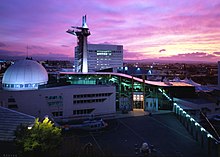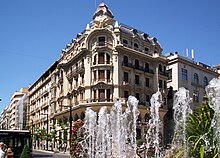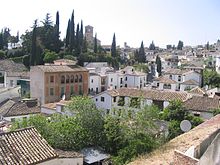Granada
| Granada | ||
|---|---|---|
| coat of arms | Map of spain | |

|
|
|
| Basic data | ||
| Autonomous Community : | Andalusia | |
| Province : | Granada | |
| Comarca : | Vega de Granada | |
| Coordinates | 37 ° 11 ′ N , 3 ° 36 ′ W | |
| Height : | 738 msnm | |
| Area : | 88.02 km² | |
| Residents : | 232,462 (Jan 1, 2019) | |
| Population density : | 2,641.01 inhabitants / km² | |
| Postal code : | 18001-18019 | |
| Municipality number ( INE ): | 18087 | |
| administration | ||
| Mayor : | Luis Miguel Salvador García ( Cs ) | |
| Website : | www.granada.org | |
| Location of the city | ||
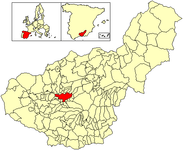
|
||
Granada is the capital of the province of Granada in Andalusia (southern Spain ) and is located in a metropolitan area of the Vega de Granada . The city has 232,462 inhabitants (as of January 1, 2019), most of whom work in the processing of agricultural products or in tourism . The University of Granada is also of great economic and cultural importance; With around 60,000 students (as of June 1, 2018), it is one of the largest educational institutions in Spain.
geography
Geographical location
Granada is located at the junction of the Sierras de Huétor y la Alfaguara in the Vega (floodplain) de Granada at the confluence of the Darro and Genil rivers at an average altitude of 734 m above sea level . The city covers an area of 87.8 km². It developed from two cores. From the top of the hill of today's Albaicín , it first grew into the Darro Valley and finally spread into the Vega due to the protection of a connecting wall (Coracha) assumed by archaeologists with the Alhambra . Today's Plaza Bibarambla (from the Maghreb-Andalusian subsidiary form Bīb ar-Ramlah from Arabic Bāb ar-Ramlah , "(city) gate of the sandbank" or "the river bed") marks its approximate medieval western expansion. The second core from which the city developed is the Realejo district . The city's Jewish origin, Ġarnāṭa al-Yahūd , is said to have been located here. The current name of this district is a hybrid of the Latin regalis ("royal") and the Arabic raḥal ("army camp").
The last 1.6 km of the route of the Darro to its confluence with the Genil have been built over by the Plaza Nueva, the Calle Reyes Católicos and the Acera del Darro since the 19th century, the river disappears at the church of Santa Ana y San Gil in the underground.
Climate table
| Granada Military Air Base (687 m) | ||||||||||||||||||||||||||||||||||||||||||||||||
|---|---|---|---|---|---|---|---|---|---|---|---|---|---|---|---|---|---|---|---|---|---|---|---|---|---|---|---|---|---|---|---|---|---|---|---|---|---|---|---|---|---|---|---|---|---|---|---|---|
| Climate diagram | ||||||||||||||||||||||||||||||||||||||||||||||||
| ||||||||||||||||||||||||||||||||||||||||||||||||
|
Average monthly temperatures and precipitation for Granada Military Airfield (687 m)
|
||||||||||||||||||||||||||||||||||||||||||||||||||||||||||||||||||||||||||||||||||||||||||||||||||||||||||||||||||||||||||||||||||||||||||||||||||||||||||||||||||||||||||||||||||||
Urban region
As the core city, Granada is located in a metropolitan area , the urban region of Granada (Área Metropolitana de Granada) , to which the following municipalities belong:
| Commune | Area ( km² ) | Population (2007) | Municipal Council (2011) | Density (inh / km²) | |
|---|---|---|---|---|---|
| Albolote | 78.58 | 117,450 | PP | 209.33 | |
| Alfacar | 16.73 | 5,316 | PP | 317.80 | |
| Alhendín | 50.81 | 5,755 | PP | 113.26 | |
| Armilla | 4.42 | 20,115 | PP | 4,555.27 | |
| Atarfe | 47.25 | 14,144 | PSOE | 299.33 | |
| Cájar | 1.65 | 4,318 | PP | 2,618.36 | |
| Cenes de la Vega | 6.49 | 6.363 | PP | 980.65 | |
| Chauchina | 21.21 | 4,537 | PSOE | 213.90 | |
| Churriana de la Vega | 6.60 | 11,162 | PP | 1,691.21 | |
| Cijuela | 17.92 | 2,455 | PSOE | 137.01 | |
| Cúllar Vega | 4.35 | 6.212 | PSOE | 1,429.10 | |
| Dílar | 79.28 | 1,638 | PP | 20.66 | |
| Fuente Vaqueros | 16.01 | 4.211 | PSOE | 263.03 | |
| Las Gabias | 39.06 | 13,950 | PSOE | 357.12 | |
| Gójar | 12.01 | 4,964 | PP | 413.29 | |
| Granada | 88.02 | 236.207 | PP | 2,683.52 | |
| Güevéjar | 9.75 | 2.234 | UPG | 229.14 | |
| Huétor Vega | 4.24 | 10,900 | PP | 2,572.17 | |
| Jun | 3.69 | 2,377 | PSOE | 644.45 | |
| Láchar | 13.12 | 2,910 | PSOE | 221.84 | |
| Maracena | 4.89 | 19,659 | PSOE | 4,020.72 | |
| Monachil | 88.92 | 6,270 | PP | 70.51 | |
| Ogíjares | 6.91 | 12,145 | APPO | 1,757.97 | |
| Peligros | 10.14 | 10,597 | IU | 1,044.78 | |
| Pinos Genil | 13.99 | 1,252 | PP | 89.48 | |
| Pinos Puente | 98.47 | 13,540 | PSOE | 137.50 | |
| Pulianas | 6.33 | 4,954 | PSOE | 782.51 | |
| Santa Fe | 38.20 | 14,934 | PSOE | 390.95 | |
| Vegas del Genil | 14.15 | 7,224 | PP | 510.43 | |
| Villa de Otura | 24.34 | 5,883 | PP | 241.68 | |
| Víznar | 13.00 | 797 | IU | 61.31 | |
| La Zubia | 20.11 | 16,941 | PP | 842.45 | |
| total | 860.64 | 490.414 | 569.82 |
Population development
Granada has around 240,000 inhabitants, of which 14,373 are from abroad. Around 23,000 people from Granada are unemployed. As a university location with up to 80,000 students, Granada is a relatively “young” city.

|
| Source: Instituto Nacional de Estadística |
| Graphic for: Wikipedia |
story
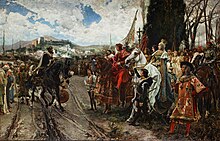
The early history of the city of Granada is controversial, but a settlement considered the forerunner of the city of Granada was first named Iliberra around 500 BC. Mentioned. Due to the protected location between the surrounding mountains and the exceptionally fertile soil, earlier settlement is likely to be strong anyway. After the conquest of the Iberian Peninsula by the Romans (see Hispania ; Latin Hispania ) a settlement with the name Illiberis is occupied. After the fall of the Roman Empire, the area initially came under the influence of the North African Empire of the Vandals , after its collapse in 534 it was under Eastern Roman rule for a few decades and then belonged to the Iberian Empire of the Visigoths from the beginning of the 7th century .
In 711 Illiberis was conquered by the Moors and the name changed to Ilbīra ( Arabic البيرة) arabized. As the administrative center of the province about ten kilometers in the northwest of today's Granada under the name Madīnat Ilbīra ( Arabic مدينة البيرة, Spanish Medina Elvira ) founded a new city: Atarfe ( Arabic الطرف, DMG aṭ-ṭaraf ) at the foot of today's Sierra Elvira , in whose toponym the name lives on. At the same time, the new name Qal'a Ġarnāṭa ( Arabic قلعة غرناطة'Castle of Granada'), from which the modern name of the city developed. Robert Pocklington sees it as the Romanesque color adjective garnet ('red').
The medieval archaeologist Antonio Malpica Cuello ( University of Granada ) rejects the equation of Illiberis with Granada. According to him, the structures necessary for a Roman city (forum, theater, etc.) are lacking, and every repetition of the assertion that Granada is Illiberis reflects “a scientific interest that is practically zero”.
After the fall of the Caliphate of Cordoba , the Berber clan chief Zāwī ibn Zīrī seized power in the province and made Granada, easier to defend than Madīnat Ilbīra , the seat of the Zīrīd dynasty , which ruled from here for around 80 years one of the most important minor kingdoms of southern Al-Andalus ruled until it was overthrown by the Almoravids in 1090 . After the Almohads were driven out , the city became the capital of the Naṣriden Sultanate from 1238 to 1492 ; these events are connected with the fall of the actual Moorish power center in Al-Andalus, Cordoba (1236); The Nasrid ruler Ibn Al-Ahmar had sided with the Christian conquerors in this conflict and is likely to have recommended himself to the people of Granada as a guarantor of peace.
In 1066 there was the Granada massacre , in which a mob murdered a Jewish vizier and most of the city's Jewish population; the bloody act is seen as the first pogrom on European soil. The event is of particular importance, since such massacres in the Moorish Al-Andalus were by no means the rule at that time. Classical Arabic historiography did not deny the massacre of 1066, but it was generally justified by the culpable or amoral behavior of the Jewish vizier Yusuf ibn Nagrela. On the other hand, the number of fatalities, which is often given as around 4,000 people, is controversial, but this is viewed, for example, by the historian Erika Spivakovsky as an exaggeration that is hardly unusual in historiography.
In 1246, the then ruler of Granada, Muhammad I ibn Nasr called Ibn Al-Ahmar, handed the city of Jaen over to the Christian powers after a month-long siege; From this circumstance and the dispatch of Nasrid armed forces to support the Christian powers in the battle for Seville in 1248, it is often deduced that Granada was actually a vassal state of the Christian conquerors and therefore survived longer than other Moorish empires in Andalusia; however, the interpretation is controversial. After the fall of the rest of the Moorish regions, many Muslims moved into the dominion of Granada.
On January 2, 1492 , the last Naṣrid ruler, Muhammad XII, surrendered . (also called Boabdil ) and handed the city over to Queen Isabella I of Castile and King Ferdinand II of Aragón , the so-called " Catholic Kings " (Reyes Católicos) . This completed the Reconquista , the "reconquest" of the Iberian Peninsula for Christianity. According to a passage in the contract concluded at the same time, the Moorish population in Granada was allowed to continue to practice their religion freely, but the Naṣrids had to leave Granada. Boabdil lived for some time in a castle in the Alpujarra that was granted to him as a fief , before moving to what is now Morocco after the death of his wife .
In the surrender treaty of Granada of 1492, the last Muslim king made various demands on the new rulers. Among other things, no Jew should be allowed to rule over a Muslim and to collect taxes from him. Furthermore, Christians should be forbidden from entering a Muslim's house or a mosque in order not to humiliate the Muslims. The new Christian rulers did not find any Christians when they arrived in the city, as these were due to oppression, public executions and crucifixions for behavior contrary to Sharia law and not least because of the exorbitantly high jizya poll tax for the dhimmi (Jews and Christians) to the north fled or bowed to pressure and embraced Islam. In addition, most of the Christians were resettled to North Africa in 1126.
In 1499, at the behest of Archbishop Jiménez de Cisneros of Toledo, a pyre was set up in the market square of Granada to burn books on Islamic theology , philosophy , historiography and science . In the course of these events there was a one-day pogrom against all non-Christians, to which Jews in particular fell victim. The quarter of the Jewish community, which had existed for several centuries, was probably largely destroyed at this time.
After the uprisings of the Muslims who remained in Spain , the so-called Moriscos (Spanish: Moriscos ), against the oppression (prohibition of religious practice, expropriation) by the new rulers, they were only forcibly relocated to other parts of the Iberian Peninsula in 1569–1571 and 1609– Expelled to Africa in 1611. Many settled in what is now Tunisia and Algeria and shaped the culture there. Granada also fell into economic insignificance. For example, silk production , for which Granada was a center in the Middle Ages, went completely under.
In 1500 the city offered the prelude to the division of Italy between Spain and France: The Partagetraktat of Granada confirmed the rights of the Crown of France to the Kingdom of Naples. The Crown Aragón turned against their own relatives, against the side line of the bastard Ferdinand enfeoffed with Naples by the Pope in 1459 . The agreement did not last beyond the common victory.
In the Spanish Civil War , Granada fell into the hands of the national Spaniards right from the start, the socialist mayor Manuel Fernández-Montesinos Lustau, a brother-in-law of the poet Federico García Lorca , was shot - like the poet - in August 1936. General Miguel Campins , stationed in Granada, was also shot by quick order ( sumarisimo ) because of his refusal to join the Francoist seizure of power at the start of the coup .
Since 1492, Granada has been the seat of an archdiocese . The University of Granada was built between 1526 and 1531 and was one of Granada's main sources of income, especially in the 20th century; After the end of the Franco dictatorship , tourism gained increasing importance.
Today around 15,000 Muslims live in Granada, of whom 1,000 to 1,500 are Spanish converts .
In 2015, Granada hosted the Winter Universiade .
See also: History of Spain
Infrastructure and traffic
The urban area is crossed by the A-44 ( Bailén - La Gorgoracha Motril ) and A-92 ( Seville - Almería ) motorways, which form an interchange to the north of Granada . Just off the A-92 in Chauchina the Granada-Jaén Airport . This was completed in 1972 and fundamentally expanded for the Alpine World Ski Championships planned for 1995 in the Sierra Nevada (which was then postponed to 1996 due to lack of snow). Around 13,000 aircraft movements occur every year. Domestic flights are primarily operated, with Ryanair and FlyMonarch serving the airport from Great Britain and Italy .
From 1904 to 1971 there were several tram lines in Granada, all of which started at Plaza Nueva. Construction of a new public rail system, the Granada light rail , began in 2007. The construction work was only completed in 2016 due to delays due to the financial crisis. The opening took place on September 21, 2017. The bus service is carried out by the company Transportes Rober .
Granada currently only has one rail connection to Almería. Due to the work for the connection to the AVE network (high-speed network in Spain), which was completed on June 25, 2019, there was only temporary bus replacement for all other connections to the nearest AVE stop in Antequera- Santa Ana. AVE traffic to and from Granada started on June 5, 2019.
Culture and sights
Granada is famous for its many important historical buildings from the Moorish period as well as from the Gothic and Renaissance periods . The city is also world-famous for its numerous guitar makers .
Alhambra
The most important buildings from the Islamic-Arab period belong to the fortress Alhambra (from al-Ḥamra'-u "the red"; Arabic الحمراء). It is a collection of palaces and the largest secular complex of its kind in Spain. It was built on older structures in the 13th and 14th centuries as the residence of the Muslim kings of the Naṣrid dynasty . The Alhambra is famous for its stucco ceilings and the lion fountain . King Charles I had a palace built in this area, which destroyed large areas of the original palace. As this is one of the most important Renaissance buildings in Spain, no excavations are carried out here. In the Alhambra there is a hotel in the building of a 16th century monastery dedicated to Francis of Assisi . Above the Alhambra is the Generalife (from Arabic جنة العارف, DMG ǧannat al-'ārif , "Garden" or "Paradise of the [God] Knower"), the summer residence of the emir . The Palacio de Carlos V is now home to the Museo de Bellas Artes de Granada (the collection institutionalized in 1839 is one of the oldest still existing picture galleries in Spain) and the Museo de la Alhambra .
Albaicín and Sacromonte
Alhambra, Generalife and Albaicín , the old Moorish quarter, are World Heritage of UNESCO . On the north side of the Albaicín there is still an interrupted remnant of the city wall of the Zīrīden from the 11th century. It begins at Puerta Elvira on the street of the same name and runs along the entire north side of the Albaicín. Particularly noteworthy are the restored Puerta de Monaita, the fortified Puerta Nueva and another city gate, which today houses a chapel dedicated to Caecilius of Illiberis . This wall has only formed the inner wall since the 14th century. The outer wall ring also stretches around the north of the Albaicín and leads over the mountain San Miguel with the church of San Miguel Alto, also known as La Ermita, embedded in the wall, also known as La Ermita, and bends there to the south, whereby the Albaicín also from East is enclosed. This wall divides the Sacromonte district into an intra- and an extramural part.
The Cármenes are typical of the Albaicín . Carmen is a term specifically used in Granada for a hillside villa with a garden. The term was derived from the Arabic karm , which means 'vineyard'. From the reign of the Naṣrids, numerous palaces have survived in the Albaicín, such as the Casa de Zafra, which survived the times as a nunnery, or the Casa del Chapiz, today the seat of the Escuela de Estudios Árabes, a subdivision of the CSIC . Closely connected with the fall of the Naṣrid dynasty is the Palacio Dar al-Horra, the residence of the mother of the last Sulṭān Boabdil . In addition, Granada has an archaeological museum, which is located in the Casa del Castril. There is also an old Ḥammām nearby , known as El Bañuelo .
Some of the churches on the Albaicín are also worth mentioning. The churches of San Nicolás and San Cristóbal are famous for being the godfathers of viewpoints (miradores) . Next to San Nicolás is the new Granada's mosque , which was completed in 2003 . San Cristóbal is a testimony to how the Moriski population of Granada were treated at the time of the Catholic Kings : Contrary to the guarantees given in the surrender of Granada , Islamic tombstones were used for the construction of the church, which are still visible in the masonry.
The Ṣaḥn ('inner courtyard of a mosque') has been preserved from the old main mosque from the 11th century . It now belongs to the Church of the Redeemer (San Salvador).
In neighboring Sacromonte you can also find the cuevas, the famous gypsy dwellings in caves. Some of them in and around Granada are still inhabited to this day. At the end of the Sacromonte quarter out of town is the Abadía del Sacromonte . The facility, which dates back to the 17th century, houses an important historical library; the collection of religious works of art and part of the building can be visited with a guide.
Around the cathedral
In the center is the cathedral from the Renaissance. Adjacent to it is the Capilla Real, completed in 1521, with the tombs of the Catholic Kings . Isabella and Ferdinand were convicted in 1521, Johanna the Mad and Philip the Beautiful are also buried there.
Around the cathedral there are still recognizable evidence of Moorish Granada in today's cityscape, such as the former Corral de Carbón caravanserai , which now houses the tourist information , the former Koran school or Madraza de Granada (entrance directly opposite the Capilla Real ) and the Alcaicería , the old silk market . Directly opposite the cathedral is the Centro José Guerrero , which has an extensive collection of the eponymous artist and hosts changing exhibitions of modern art.
The 18th century neoclassical Palacio de las Columnas now houses the translation and interpreting faculty of the city's university. Nearby is the 16th century Colegio de San Pablo . This building was used by the Jesuits to train missionaries for the Moriski population. After the dissolution of the Jesuit order in Spain in 1767, the law faculty moved here, which is still located in the building to this day. The Jardín Botánico is attached to the building . A little further away is the monastery of St. Jerome . This monastery, built in the Isabelline style, is the first monastery to be built after the city was handed over to the Catholic Monarchs . It serves as the burial place of the Gran Capitán .
Other sights
Just west of the Alhambra, on the other side of the Rio Darro embankment, is the Archaeological Museum of Granada . North of the center is the richly decorated Carthusian monastery of La Cartuja , which also houses an art collection with works by the Baroque artist Juan Sánchez Cotán and others. can be visited. The Granada's observatory is located on the university campus named after the monastery. Nearby is the new Plaza de Toros from the 1920s, built in neo Mudejar style.
Next to the Jardines del Triunfo is the Capuchin Church of Granada with the crypt of Fray Leopoldo , widely venerated in the Granada region; in fact, due to the high number of visiting believers, it is the second most visited monument in the city. In the south of the city, on the other side of the Genil , are the Congress Palace, the Science Park and the Almohad hunting lodge , the Alcázar del Genil.
Festivals and celebrations
Like other cities in Spain, Granada also has its own festivals in addition to the general festivals. Most are of religious origin.
- January 2nd: Día de la Toma . The 'Day of the Capture of Granada' commemorates the handover of the city by Boabdil to the Catholic Monarchs in 1492. The day is traditionally accompanied by marches by nationalist and falanguist groups, and left counter-demonstrations have increased in recent years.
- February 1st: San Cecilio . Feast day of St. Caecilius of Iliberris is February 1st. Usually, however, the day is celebrated on the following first Sunday in February with a pilgrimage ( Romería ) to the Abadía del Sacromonte.
- End of March: Fiesta de la Primavera . The 'Spring Festival' is a relatively new invention, stimulated by the communication possibilities of social networks . It is seen by many as an excuse for the officially forbidden botellón , excessive alcohol consumption in public. In the Spanish media , the term Macrobotellón was coined for this botellón, which was allowed in a narrowly defined area , and which is said to have gathered up to 25,000 young people in 2011 .
- The Semana Santa , which begins Palm Sunday and ends at Easter , is celebrated in Granada, as in many other cities in Spain, with many processions of the various Cofradías or Hermandades . It is less famous than the Semana Santa in Seville , but several processions take place here every day on different routes. The best known is the procession of the Gitanos to the Abadía del Sacromonte.
- May 3: Fiesta de la Cruces or Cruz de Mayo . This festival is also celebrated throughout the Spanish-speaking world. However, Granada is known for the competition between the individual districts to set up the most beautiful flower-adorned cross or the most beautiful religious scene.
- The Feria del Corpus, i.e. the Corpus Christi holiday , is the largest feria in the city, which traditionally takes place on the days before Corpus Christi on the holiday area in the north of the city. Institutions and political parties maintain marquees here, and the fairground rides stand next to them.
- The Fiesta del Agua ('Festival of Water'), which is actually celebrated as Fiesta del Agua y del Jamón ('Festival of Water and Ham') in the mountain village of Lanjarón in the Alpujarras . But it is also celebrated privately on various dates on the streets and squares of Granada. This includes jumping over fire as well as water battles. The largest water fight, which has been taking place regularly for years, takes place in the Realejo district around August 1st.
media
Town twinning
Granada has partnered with the following cities :
-
 Aix-en-Provence , Provence , France
Aix-en-Provence , Provence , France -
 Belo Horizonte , Brazil
Belo Horizonte , Brazil -
 Coral Gables , Florida , USA
Coral Gables , Florida , USA -
 Freiburg im Breisgau , Baden-Wuerttemberg , Germany
Freiburg im Breisgau , Baden-Wuerttemberg , Germany -
 Marrakech / مراكش, Morocco / المغرب
Marrakech / مراكش, Morocco / المغرب -
 Tétouan / تطوان, Morocco / المغرب
Tétouan / تطوان, Morocco / المغرب -
 Tlemcen / تلمسان, Algeria / الجزائر
Tlemcen / تلمسان, Algeria / الجزائر
Granada is also a member of the Federation of European Napoleonic Cities .
sons and daughters of the town
- Jehuda ibn Tibbon (1120–1190), translator, physician and poet
- Luis de Granada (1504–1588), Dominican and Ascetic writer
- Francisco Suárez (1548–1617), theologian and philosopher
- Alonso Cano (1601–1667), painter, sculptor and architect
- Pedro de Mena y Medrano (1628–1688), sculptor
- Mariana de Pineda Muñoz (1804–1831), heroine of liberalism
- Eugénie de Montijo (1826–1920), Empress of France
- Manuel Gómez-Moreno (1870–1970), art historian, archaeologist and epigraphist
- Francisco Alonso (1887–1948), composer
- José María Granada (1893–1960), playwright, screenwriter and director
- Federico García Lorca (1898–1936), writer
- Agustina González López (1891–1936), writer and feminist
- Francisco Ayala (1906–2009), writer and sociologist
- José Tamayo (1920–2003), theater director and director
- Enrique Morente (1942-2010), flamenco singer and composer
- Miguel Ríos (* 1944), musician
- Carlos Cano (1946–2000), singer, composer and songwriter
- José Higueras (born 1953), tennis player
- Javier Paxariño (* 1953), jazz musician
- Clara Aguilera García (* 1964), politician
- José Rico Pavés (* 1966), Catholic clergyman, Bishop of Jerez de la Frontera
- María José Rienda (* 1975), ski racer
- Manuel Calvente (* 1976), racing cyclist
- Álvaro Gijón (* 1976), cross-country skier
- Francisco José Lara Ruiz (* 1977), racing cyclist
- Juan Miguel Mercado (* 1978), racing cyclist
- Adolfo García Quesada (* 1979), racing cyclist
- José Antonio Sánchez de Luna (* 1984), tennis player
- Enrique Jiménez (* 1985), ancient orientalist
- Kid Simius (born 1987), musician
- Victoria Padial (* 1987), biathlete
- Pablo Aguilar (* 1989), basketball player
- Irene Espínola Pérez (* 1992), handball player
- Laura Bueno (* 1993), sprinter
- Ignacio Fontes (* 1998), athlete
See also
Web links
- City Council of Granada (Spanish)
- Illustration of the city 1565 in Civitates orbis terrarum by Georg Braun and Frans Hogenberg
Individual evidence
- ↑ Cifras oficiales de población resultantes de la revisión del Padrón municipal a 1 de enero . Population statistics from the Instituto Nacional de Estadística (population update).
- ↑ http://www.juntadeandalucia.es:9002/sima/htm/sm18087.htm
- ↑ See the key words in the Diccionario de la Real Academia Española realejo , real ² and real ³
- ↑ As of July 29, 2010, http://www.juntadeandalucia.es:9002/sima/htm/sm18087.htm
- ^ Robert Pocklington: La etimología del topónimo Granada. In: Al-Qantara, 9: 2 (1988), pp. 380-401. Analogous to the Romanesque granado / a , it refers, inter alia, to on the Alhambra, whose name is derived from the Arabic color adjective for red, aḥmar, and on translations of the city name into Arabic: Ḥiṣn ar-Rummān - 'pomegranate castle '.
- ^ Antonio Malpica Cuello: Granada, ciudad islámica. Mitos y realidades. Liberbolsillo, Granada 2000, ISBN 84-89685-26-6 (PDF; 14.3 MB).
- ↑ Antonio Malpica Cuello: ¿Sirve la arqueología urbana para el conocimiento histórico? El ejemplo de Granada. In: Lorenzo Cara (ed.): Ciudad y territorio en al-Andalus. Granada 2000, pp. 21-59, here p. 50.
- ^ Richard Gottheil, Meyer Kayserling: Granada. In: Isidore Singer (Ed.): Jewish Encyclopedia . Funk and Wagnalls, New York 1901-1906.
- ↑ Alejandro García Sanjuán: Violencia contra los judíos: El pogromo de Granada del año 459 H / 1066. In: Maribel Fierro (ed.): De muerte violenta. Politica, religón y violencia en al-Andalus. Consejo superior de investigaciones cientificas, Madrid 2004, pp. 167-206 (stored on Academia.edu ).
- ↑ Erika Spivakovsky: The Jewish presence in Granada. In: Journal of Medieval History. 1971, pp. 215-238.
- ^ Hugh Kennedy: Muslim Spain and Portugal. P. 276 ( limited preview in Google Book search).
- ^ Serafin Fanjul: Al-Andalus contra Espana . Siglo XXI, 2005, p. 248 .
- ↑ Vincent Lagardére: Communautés mozarabes et pouvoir almoravide en al-Andalus . In: Studia Islamica 67 . 1988, p. 99-119 .
- ↑ Bartolomé Bennassar, Jean-Pierre Amalric, Jacques Beyrie, Lucienne Domergue: Histoire des Espagnols XVIII e –XX e siècle . In: Marguerite de Marcillac (Ed.): Tempus . 2nd Edition. tape 2 , no. 378 . Editions Perrin, Paris 2011, ISBN 978-2-262-03441-2 , pp. 445 .
- ↑ Keith Barrow: Granada opens first light rail line. In: railjournal.com. September 21, 2017 (English), accessed September 29, 2017.
- ↑ Spain: Granada with connection to the high-speed rail network. In: eurailpass.de. June 26, 2019, accessed July 10, 2019 .
- ↑ where: AVE arrives in Granada . In: Eisenbahn-Revue International , p. 372.
- ↑ Carmen. In: Diccionario de la lengua española. Real Academia Española .
- ↑ Juan Ramón Olmos: Fiesta de la Primavera de Granada: 25,000 jóvenes. In: ideal.es. March 18, 2011.
- ^ Ciudades hermanadas ( Memento of April 28, 2012 in the Internet Archive ). In: Granada tu favorita.


